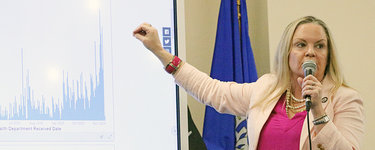‘We have to stand our ground’ says county exec as COVID-19 cases reach earlier peak
ALBANY COUNTY — As COVID-19 cases and hospitalizations continue to climb, county officials gave stern warnings on Tuesday morning about following protocols to stem the spread of the virus.
“Our numbers are going in the wrong direction and I’m very concerned,” said the county’s health commissioner, Elizabeth Whalen, as she pointed to a graph that shows the current number of cases nearly as high as the apex reached in the spring.
Sixty-eight new cases were announced at the press briefing and 36 county residents are currently hospitalized with the disease; five of them are in intensive-care units.
“We’re as high as we were in mid-April when we hit our peak,” said Whalen. “And what happened at that stage? We were shutting down … No one was leaving their home … Now we have kids back in school. We have people back in their places of work so what am I concerned about?”
She answered herself, “This number is going to go up unless people change their behavior, unless people are very vigilant with what they do.”
Albany County Executive Daniel McCoy noted there had been over 400 new COVID-19 cases since last Monday. The uptick in cases that the county had expected in January or February, he said, is here now.
“We have COVID-19 fatigue …,” said McCoy. “We have to stand our ground.”
He again urged people who test positive for the virus to be honest about where they had been as the health department traces contacts.
“If you want to stop the spread and you don’t want to shut businesses down again and you want to get back to somewhat of a new normal … we need your help,” said McCoy.
“This is where we hoped we wouldn’t get and we’re there and it could get worse, and, if behaviors don’t change, it will get worse,” said Whalen.
Whalen noted that, on average, every person with COVID-19 infects two to three people. “We might see even more than that of late,” she added.
She told parents it is not enough to keep children with symptoms, like coughs or fevers, home for 10 days. “You must test and you must share contact information,” she said. “This is the only way we can stop the spread of COVID.”
Whalen admonished those at the press conference who did not have masks covering their noses and mouths: “Put your mask on the right way … Otherwise, you’re not protecting yourself; you’re not protecting other people.”
She went on, “We don’t want to resort to wide-scale shutdowns. I am fully aware of the psychological and economic and other implications and the toll that this pandemic has taken on the county, on this state, and on this country. But the responsibility is to each one of us individually to do what we need to do to protect ourselves, to protect our families, and to protect our communities.”
Whalen urged, “Ask yourself every time you go out, do you need to go out — and how will you protect yourself.”
She also said, “We could have stopped this in the beginning if people had listened to this advice. Viruses need hosts; they need somebody to infect. If you stop the train of transmission, the virus has nowhere to go. This country has done a poor job of stopping this transmission.”
The state has adopted an approach of tamping down on microclusters of the disease by naming red zones with heavy restrictions where over-sampling is done. Surrounding orange zones have lesser restrictions, and outlying yellow zones have lesser restrictions still.
Whalen said that her department regularly deals with “micro-micro-clusters” of perhaps two or three infections. Those schools or businesses have then closed voluntarily.
“We’ve been doing that since the beginning,” said Whalen.
She noted that someone infected with COVID-19 spreads the disease for two days before symptoms appear. “You spread this virus before you know you have it,” she said.
Lately, she said, the county has seen more severe rates, hospitalizations, illnesses, and death.
“That is why testing is essential,” Whalen stressed. “If we don’t know where it is, we can’t control it.”
Governor Andrew Cuomo announced on Tuesday that the positive rate, based on Monday’s test results in all of the state’s micro-cluster zones was at 5.59 percent. Statewide, the positivity rate was 3.09 percent.
The initial goal had been to keep the positivity rate below 1 percent. None of the state’s 10 regions was below 1 percent. The Capital Region, of which Albany County is a part, was at 2.9 percent. Western New York and Central New York were the highest , each at 5.7 percent.
Cuomo again released a chart, from Johns Hopkins, of all 50 states and the District of Columbia ranked by COVID-19 positivity rate over the past week, showing New York State as the third lowest.
Vermont was the only state below 1 percent, at 0.64 percent. Maine was next lowest at 2.02 percent followed by New York at 2.07 percent. South Dakota was the highest at 53.97 percent.
Cuomo again stressed, “Local governments need to be vigilant and actively enforce public health law throughout the state.”
At the county press briefing, McCoy was asked if punitive measures would be taken against organizers of a basketball tournament in Cohoes where spectators, many without masks, were closely pressed together.
“We’re not looking to fine people …,” McCoy said. “It’s not just the organizer. It’s the parents, too.”
He urged anyone who attended the event to get tested.
Albany Med restricts visits
Also on Tuesday, Albany Medical Center announced it will restrict patient visits beginning on Wednesday, Nov. 11.
“Visitors will be limited to those with loved ones near the end of life, parents or guardians with hospitalized children and birthing partners,” Albany Med said in a release. “Compassionate exceptions may be made on a case-by-case basis. Hospitals throughout the region are taking similar measures.”
NYSUT launches its own tracker
New York State United Teachers has launched a new website, NYSUTCovidTracker.org, meant to track coronavirus-related health and safety concerns in schools across the state.
“The website is intended to crowdsource reports of health and safety violations and concerns identified by school staff members, parents, and community members,” said a release from the union. It includes a mapping tool that shows district-by-district information reported to NYSUT to help community members easily identify the issues in their region.
The state already has a website, called COVID-19 Report Card that tracks virus cases at every school in the state.
“By empowering educators and community members to report their concerns, it’s our hope that we can elevate the voices of those who otherwise may go unheard,” NYSUT President Andy Pallotta said in the release. “Communities should receive not only real-time COVID-19 infection data, but also a fuller picture of the issues educators are raising with their administrators.”
Bar association calls for vaccination mandate
The New York State Bar Association has recommended that the state consider mandating a COVID-19 vaccine once a scientific consensus emerges that it is safe, effective, and necessary. But before doing so, the state government should conduct a public awareness campaign to urge voluntary vaccination, the association says.
NYSBA’s House of Delegates approved a resolution on Nov. 7, outlining conditions for requiring the vaccine for all New Yorkers, except those exempted by doctors. It would be up to public health authorities to decide if a vaccine mandate is necessary, and whether it should apply to all residents or a smaller population such as health-care workers or students.
The bar association is asking the state to ensure that vulnerable populations are treated ethically and without discrimination. This includes communities of color, older adults, nursing home residents, people with disabilities, prisoners and immigrants.
It is also asking that the state enact an emergency health powers act and crisis standards of care addressing gaps in existing law to ensure a well-coordinated response to the pandemic, increasing the capacity of the system if there’s a surge in cases. It would also clarify the legal authority and ethical standards for making decisions if there are shortages of anything from personal protective equipment to trained health care workers.
“In balancing the protection of the public’s health and civil liberties, the Public Health Law recognizes that a person’s health can and does affect others,” said Mary Beth Morrissey, chair of the Health Law Section’s Task Force on COVID-19, which proposed the resolutions approved by the House of Delegates this week.
Newest numbers
As of Tuesday morning, Albany County has 4,016 confirmed cases of COVID-19. Of the 68 new cases, 32 had close contact with someone infected with the disease, two reported traveling out of state, 29 did not have a clear source of infection identified at this time, and five are health-care workers or residents of congregate settings.
Currently, 1,437 county residents are under quarantine, up from 1,389. The five-day average for new daily positives increased to 55 from 50. There are now 367 active cases in the county, up from 337 on Monday.
So far, 17,800 county residents have completed quarantine. Of those, 3,649 had tested positive and recovered.
Thirty-six county residents are hospitalized, up from 32 on Monday; five of them are in intensive-care units. The county’s hospitalization rate has gone up to 0.89 percent from 0.81 percent.
Albany County’s COVID-19 death toll remains at 144.



